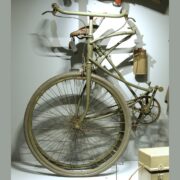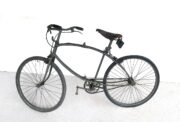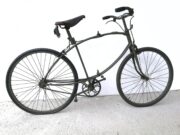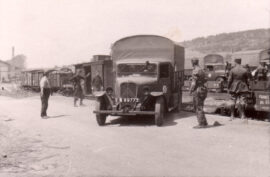
03 British BSA Airborne Folding Paratroopers Bicycle, 1942
Fotogalerie




In 1941, the British War Office asked the Birmingham company B. S. A. (Birmingham Small Arms Company) to make a folding bicycle for paratroopers. The company had experience with producing folding bicycles for the army dating back to the First World War. However, this time, the bicycle had to be much lighter. The original specification was 30 lbs (approximately 13.6 kg) but in the development process, the weight of the bicycle had changed twice more with the final requirement being 22 lbs (approximately 10 kg).
In order to achieve that, the company’s designers had to significantly change the frame of the bicycle. It newly consisted of a two-tube elliptical frame that better resisted the impact of the bicycle hitting the ground after being dropped with a parachute from an airplane. The saddle bar also had two tubes. The parachute itself was attached to the wheels so that the bicycle hit the ground with its handlebars and seat. The hinges that allowed for the bicycle to be folded were attached with wing nuts and positioned on top of each other on elliptical tubes. The new design reduced the weight to 21 pounds.
The resulting bicycle was not very robust by the standards of the time, which raised doubts among War Office experts. However, official tests showed that the bicycle could resist much harsher treatment than expected for paratroopers. The tests themselves also impressed observers from the U.S. and Soviet delegations; prototypes were sent immediately after their completion to both countries. The bicycle was used throughout the rest of the war and took part in all major campaigns, such as the Allied landings at Normandy, Operation Market Garden, and others.
Aktuálně

Pojízdné zařízení pro očistu bojové techniky TZ-74 GABRIEL

Oceňovaní spojenci - Pozemní útvary československé branné moci v bitvě o Francii očima francouzského velení

Vánoce a přelom roku v zahraniční misi na Slovensku v roce 2022









